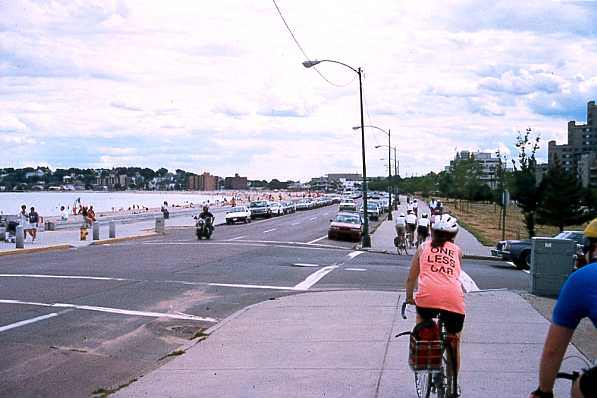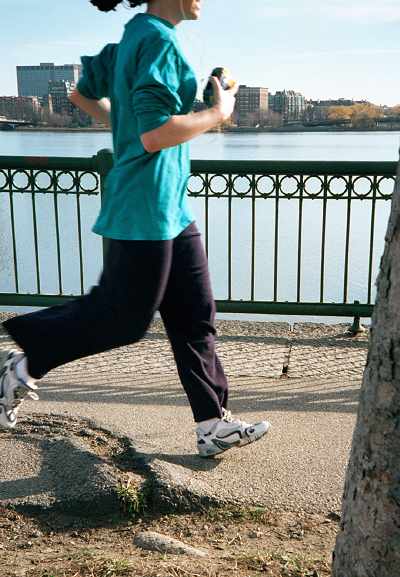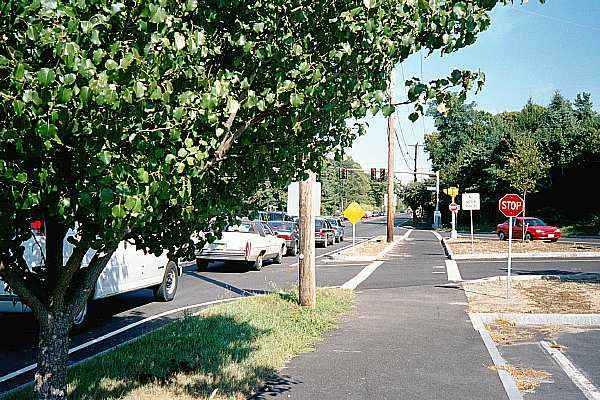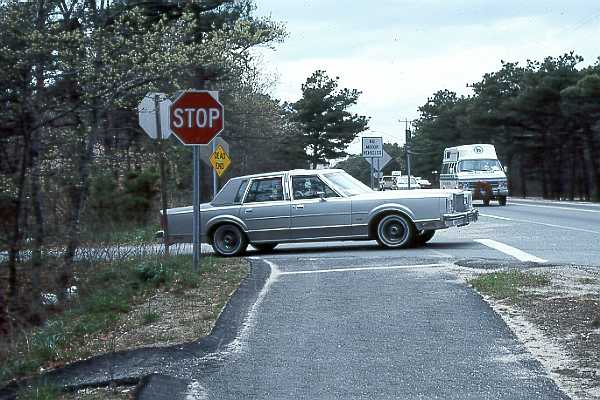JOHN S. ALLEN'S BICYCLE FACILITIES, LAWS AND PROGRAMS PAGES |
||
 |
Top: John S. Allen's Home Page Up: Bicycle sidepaths Contact John S. Allen by e-mail |
 |
JOHN S. ALLEN'S BICYCLE FACILITIES, LAWS AND PROGRAMS PAGES |
||
 |
Top: John S. Allen's Home Page Up: Bicycle sidepaths Contact John S. Allen by e-mail |
 |
Sidewalk of Revere Beach Parkway, Lynn, Massachusetts.
Signs have been posted on the parkway prohibiting
bicyclists from riding in the roadway, though Massachusetts
law does not permit such a prohibition.
 Doug Mink photo |
Technical issues with sidewalks and sidepathsSidewalk-type bicycle facilities were first built in Europe before the Second World War, when no research base existed. Research dating as far back as 1938 has shown that sidewalk-type facilities have serious civil engineering, safety, operational and liability problems, and that it is far preferable for bicyclists to travel either on the roadway, or on separated paths which are entirely away from roadways. Europe has many more sidewalk-type facilities than the U.S., having gotten into the habit of building them before there were research results to warn against them. A strong backlash against them has occurred there in recent years in response to crash studies, and to the observation that these facilities are often poorly maintained and allow only for slow travel. A press release by the ADFC (the national German bicyclists' organization) gives an example of the tone of the discussion occurring at present. Elevated crash riskSidepaths have a higher rate of bicycle-motor vehicle collisions than streets have. The research literature overwhelmingly demonstrates this conclusion. [See other Web page with links to research reports] This conclusion may seem surprising at first to people who are not familiar with the research literature. However, the overwhelming majority of car-bicycle collisions-- approximately 90% --involve turning and crossing movements. Sidepaths complicate these movements by placing the bicyclist and motorist out of sight of each other and on conflicting paths at junctions with streets and with driveways. Bicycle crashes which do not involve motor vehicles are rarely reported to police. However, as shown in all studies which are population-based, bicycle/motor vehicle collisions are only 10% to 20% of injury-producing bicycle crashes. The comparison between sidepaths and roads for crashes which do not involve motor vehicles is extremely unfavorable to sidepaths. In particular, the more restrictive geometrics of sidepaths lead to more single-bike crashes; also, bicyclists can not travel safely at normal speeds in the presence of pedestrians, because pedestrians suddenly and unpredictably change direction. In a collision between a bicyclist and a pedestrian, both are vulnerable, and so pedestrian injury rates also increase greatly from the placing of bicycles on sidewalks. As first demonstrated in the Cross and Fisher study conducted in the 1970s, and as confirmed for the Boston area in the 1984 Metropolitan Area Planning Commission study posted on this Web site, only a small percentage of car-bicycle collisions on roadways is overtaking collisions. The false belief that car-overtaking-bicycle collisions are the predominant car-bicycle collision type is in large part responsible for the excessive fear of that type of collisions, and the false idea that placing bicyclists on sidewalks will increase safety. Would any traffic engineer design a divided highway with two-way traffic on each of two or three parallel roadways? This is the description of a street with sidepaths! The problem of conflicts at junctions with sidepaths can be reduced only by measures that substantially slow or delay bicyclists, motorists or both. Even the most advanced measures of this type do not succeed in reducing the crash rate to that for riding on streets. Civil engineering issuesRoot damageTree roots heave up pavement as they grow. This problem is especially serious for sidepaths because trees will find water more abundant beyond a sidepath than on the street side. Root damage is an endemic problem on bicycle paths but only rarely a problem in streets. That is because streets are wide enough to shield the soil beneath them from water percolation, and are bordered by deep curbstones which serve as root barriers. Pedestrians can tolerate pavement heaved up by roots, but for bicyclists it is a serious hazard. A root across the bicyclist's line of travel causes a jolt and possible loss of control. A root that is more nearly parallel to the bicyclist's line of travel can sweep the bicyclist's front wheel to the side, causing a "diversion-type fall" which typically results in injury to the hip, shoulder or head. An example of root damage on a bicycle sidepath is shown in the photographs below. Root damage can be prevented by installing root barriers or by removing trees, but these measures are usually not taken. A sidepath along a tree-lined boulevard is especially prone to this problem, and also to sight-line problems as tree trunks block the view. |
Root damage on Paul Dudley White bicycle path near
MIT's Pierce Boathouse, Cambridge, Massachusetts, USA

Drainage.Streets are crowned to facilitate water runoff, and are provided with storm grates, catchbasins and storm sewers. Even if a sidepath is sloped to facilitate drainage toward the street, puddling will occur increasingly over the years as the soil settles and as roots heave up the path. When plowed snow blocks drainage to the street, drainage will be completely blocked over long segments of the path. Snow and ice.Snow removal from a sidepath is never a successful as from a street. On a street, motor vehicle tires wear away snow, and quickly open up patches of pavement, which facilitate heating by sunlight to complete the melting. In addition, a more aggressive use of snow-melting chemicals is practical on streets, where they are carried away in the storm drain system and do not pose a substantial risk of damage to roadside vegetation. Particularly when drainage is blocked by plowed snow and by heaving up due to tree roots, puddles on the path refreeze into ice, making the path unsafe for bicycle travel. Ice puddles are a far less serious problem in a street, because it is crowned and because of its drainage provisions. Plowed snow from driveways blocks a path until cleared from the path. No such problem occurs with streets. All in all: Pedestrians can tolerate heaving by roots and imperfect snow clearance, and can even beat a path for themselves where there is no snow clearance. Bicyclists cannot. After a snowfall, sidepaths remain unusable, and then unsafe, for bicycle travel far longer than streets. An important advantage of on-roadway facilities, aside from greater safety, is that they are relatively inexpensive to construct, and much easier to maintain. Operational issuesInevitability of two-way bicycle travelMany sidepaths or "cycle tracks" are designed based on the faulty assumption that they will carry only one-way traffic on each side of the street. This assumption is highly unrealistic because, with paths behind curbs and sometimes behind parked cars, it is inconvenient to cross the street to enter the path on the other side. Easy crossing can be accomplished only where there is a curb cut or driveway. Getting to the nearest entry point for the opposite sidepath requires either riding away from the intended destination and then making a U-turn, or riding the wrong way on the sidepath -- the more likely choice. Many of the entry points for the two sides are not opposite one another, and so it will often be necessary to lift the bicycle over a curb, or else ride along the narrowed street to get from one sidepath to the other -- the more likely choice. Crossing to a street-level bike lane or the opposite travel lane of a normal street poses no such problems. Bicyclists riding opposite the traffic flow will be subject to the very high risk associated with crossing intersections on the left crosswalk, as described in the studies cited above. Are pedestrians separated from bicyclists?When pedestrians share space with bicyclists, there are no reliable rules for overtaking. This is true even if separate parts of the sidepath's width are designated for bicycles and pedestrians. Consider, for example, the common European practice of striping a sidewalk so the part nearest the street is designated for bicycles. When one bicyclist is overtaking another traveling in the intended direction, the tendency will be for the slower bicyclist to remain in the bikeway, while the faster bicyclist merges to the right -- not to the left as with normal overtaking -- and into the sidewalk area. This confusion puts both of the bicyclists at risk, as well as pedestrians. A very confusing situation occurs when a "wrong-way" and "right-way" bicyclist approach one another. One or the other bicyclist will have to merge into the area designated for pedestrians. Which bicyclist? The "right-way" bicyclist may feel justified in keeping a straight course on the designated bikeway, but then the "wrong-way" bicyclist will have to pass to the right of the "right-way" bicyclist, contrary to the usual traffic rules. Suppose that the "right-way" bicyclist yields to the right as is normal, and the "wrong-way" bicyclist yields to the left, assuming that the "right-way" bicyclist will stay in the designated bikeway? Then they collide head-on. Confusions become far more complicated when bicycle and pedestrian traffic is heavy, and they lead to bicycle-pedestrian collisions as well as bicycle-bicycle-collisions. By way of comparison, the standard overtaking rules on the roadway are simple and clear: slower traffic keeps right and faster traffic overtakes on the left after looking back to check that there is not another vehicle (bicycle or motor vehicle) already overtaking. Confused yielding rules, sight obstructionsOn the street, through traffic has the right of way over turning traffic. On the sidepath, because of sight line problems, both through bicycle traffic and crossing motor traffic must slow and be prepared to yield, since neither the bicyclist nor the motorist can be sure to see the other in time. The problem occurs because the bicyclist is hidden behind parked cars, or in the right rear blind spot of a motor vehicle which has slowed to turn. It is typical in this situation to install stop signs for the path as well as the road. The example below is from the Route 28 bicycle path in Hyannis. Bicyclists on the path must yield at the stop sign, and turning vehicles must yield at the crosswalk marking. |
Sight obstruction by tree, bicyclist in camera position
would be in
motorist's right rear blind spot; also right-of-way confusion.
Route 28 bike path, Hyannis, Massachusetts, USA.

Blocking of street by vehicles waiting to exit it, and
|
Car blocking path, Route 28 bike path, Hyannis, Massachusetts, USA

Bicyclists will still use the street.Sidepaths do not eliminate the need or desire of bicyclists to ride in the roadway, for several reasons, some already stated
Bicyclists do not belong on sidewalksWalking a bicycle in order to avoid challenging traffic conditions is sometimes appropriate, especially for children and novice bicyclists. Without sidepaths, bicyclists still have the option to ride slowly, or walk their bicycles, on sidewalks and to cross intersections as pedestrians if they wish to do so. However, riding in the street is much faster, and adult bicyclists do not put up with slower travel except under unusually difficult conditions. Pedestrian-type facilities are a hindrance rather than an aid to bicyclists who expect to be able to get to their destinations quickly. These facilities create a chaotic, disorganized traffic pattern and increased risk of crashes. Appropriate and inappropriate arguments for sidepathsBicycle routing on a sidewalk or sidepath can make sense where traffic conditions are extreme and there is no cross traffic: for example on a highway bridge with high-speed traffic, narrow lanes and no shoulders. A path along a limited-access highway avoids the problem with cross traffic and can make sense where it connects trip generators along the same side that are only accessible by longer routes away from the highway. There are more such trip generators in urban and suburban areas than in rural areas. Connections should be provided to every neighborhood along the paths. There may be a problem with grading the path to acceptable standards, however. A path on one side of the highway can serve trip generators that side only, for bicyclists and pedestrians. On the other hand, bicycle access on the shoulders of a limited-access highway, with connecting paths (bicycle on- and off-ramps) between interchanges can serve trip generators on both sides, but only in one direction for each side and only for bicyclists. Snow removal is generally not a problem for access on the shoulders, as it is on a path. I think that it is also worth bearing in mind that much of the attraction of a separate path is in its being in a scenic area away from the noise and smell of traffic. Therefore, while paths parallel to limited-access highways can make sense as transportation links, they tend to be unattractive as recreational facilities. The two most common arguments that have been made for sidepaths are that they are safer, which is incorrect except under unusual conditions, and that people think they are safer. The latter argument, sometimes made naively and sometimes not, frequently becomes a basis for political action, on grounds that people should be encouraged to abandon motorized transportation for bicycling and walking. But construction of facilities that make bicycling more dangerous and slower amounts to shooting oneself in the foot on the encouragement issue, and is unethical. |
| Top: John S. Allen's Home Page Up: Bicycle sidepaths Contact John S. Allen by e-mail |
Copyright 2002, John S. Allen |